Consolidated Management Report
Consolidated Financial Statements
Sustainable development of the business
Responsible environmental management
Cellnex bases its activity on the principles of sustainability and responsibility and has therefore defined a Strategic Sustainability Plan, which was approved by the company’s senior management in 2019. The project aims to raise the level of the company’s responsibility in the field of sustainability to work towards becoming a leader in environmental management. The plan also seeks to achieve a high level of commitment among the company’s stakeholders that contributes to increasing their environmental awareness.
The Strategic Sustainability Plan covers five years (2019-2023) and has been drawn up within the framework of the CR Master Plan (2016-2020). This Plan will be integrated into the next CR Master Plan (2020-2025).
The Plan is part of the company’s daily activities and is structured around 11 lines linked to the United Nations Sustainable Development Goals (SDG). To that end, we carried out an analysis of the company’s risks and opportunities in order to identify the Sustainable Development Goals that Cellnex may influence, beginning with the definition of three strategic goals related to sustainability.
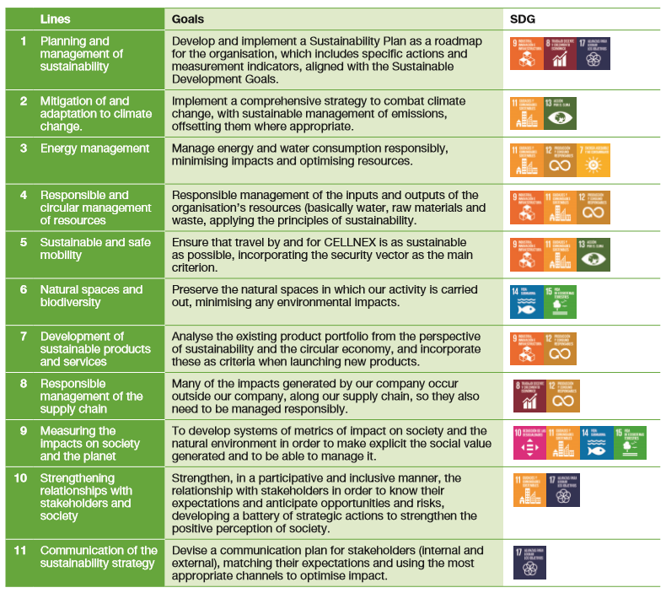
On the basis of the corporate goals, it will set up specific goals for the different geographical areas and standardise global management systems and regulations at Group level.
As shown in the figure above, the first strategic line of the Plan consists of planning and management of sustainability, for which an Action Plan will be devised. The Action Plan will include more detailed actions that facilitate the execution of the Strategic Plan in order to plan, communicate, train and implement a certifiable management system.
Over the coming years, the development of the Action Plan aims to design the implementation and future certification of a global integrated management system under a number of International Standards (ISO 9001, ISO 14001, ISO 45001, AS8000, with a focus on energy certification ISO 50001) for all business units.
On the other hand, Cellnex Spain has an Environmental Policy based on respecting the environment, protecting and preserving biodiversity, using renewable energies, mitigation of and adaptation to climate change, and contributing to sustainable development through the efficient use of resources, as well as promoting preventive and mobility actions.
MAIN ACTIONS IMPLEMENTED IN 2019 / KEY FUTURE ACTIONS TO BE IMPLEMENTED IN 2020
|
Main actions implemented in 2019 |
Key future actions to be implemented in 2020 |
1 |
Devise an action plan |
Plan the implementation of a global integrated ISO system for its future certification |
2 |
Draft a Strategic Plan for carbon management |
Incorporate Ireland and other acquired companies in the calculation of the Cellnex Carbon Footprint of. |
3 |
Sign Green Power Purchase Agreement in Spain |
Define the global energy management model as well as the company's energy efficiency plans, aligned for possible ISO certification. |
4 |
Valuing almost 100% of the waste generated directly from our activity in Spain. |
Carry out a Life Cycle Analysis. Perform an analysis of climate scenarios following the recommendations of the TCFD. |
5 |
Carrying out studies on sustainable and safe mobility in Spain |
Work on the development of a safe and sustainable Travel/Mobility Plan. |
6 |
Evaluation of the sites acquired until the first quarter of 2019 (assess whether these are natural and/or protected areas and the regulations that apply to them.) |
Identify natural spaces and applicable regulations. Keep in step with legislation relevant to the management system. Prepare of the environmental impact map. |
7 |
Planning of possible actions |
Analyse the life cycle of the main products/services. |
8 |
Maintenance of the value chain with CDP Supply Chain suppliers. During 2019 suppliers from France, the Netherlands, and Switzerland join. |
Incorporate environmental and social criteria in contracting processes. Maintain the value chain with CDP Supply Chain suppliers and maintain or improve the current index. |
9 |
Plan actions from 2020 onwards. |
Plan a systematic follow-up to UN SDG. |
10 |
Actions in coordination with the Management of Corporate & Public Affairs |
Plan action with the CSR unit of Corporate & Public Affairs Management. |
11 |
Actions in coordination with the Management of Corporate & Public Affairs |
Plan action with the CSR unit of Corporate & Public Affairs Management. |
Monitoring and managing the main risks, opportunities and environmental impacts
Within the environmental management system already implemented and certified, Cellnex Spain periodically updates the identification and evaluation of its environmental aspects, risks and opportunities related to the company's activity and the derived environmental impacts, as well as the significance criteria. The most significant impacts are extracted from these evaluations, to which end a monitoring system is established and actions are planned to mitigate them. The following risks were identified during 2019:
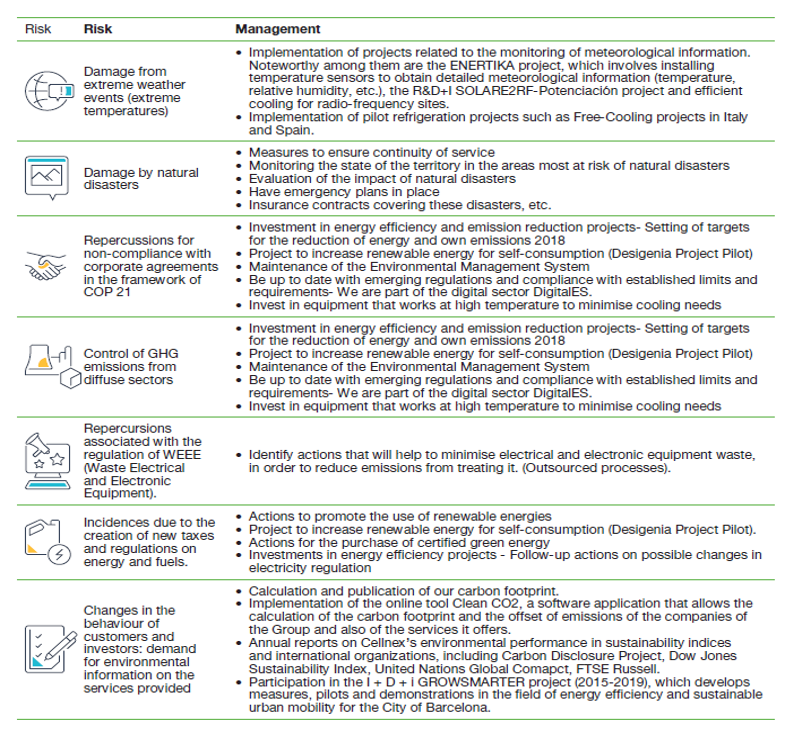
Sustainable use of resources
Owing to the nature of Cellnex's business, the only material environmental aspect is, energy. In this context, Cellnex monitors the organisation’s energy consumption to achieve maximum efficiency and the lowest possible impact on the environment and hence on society.
Most of Cellnex's electricity consumption comes from its sites and, to a lesser extent, its offices. In 2019, the company's total electricity consumption was 563,003,094 kWh (460.972.053 kWh in 2018).
Cellnex is committed to using renewable energies, as borne out by the Cellnex Netherlands practice of buying 100% green energy, Cellnex UK aims to buy green energy in 2020and Cellnex Italy has issued a tender for its energy supplier that specifies that 30% of power must come from green sources by 2021. Also, Cellnex Switzerland uses 100% renewable electricity (water and solar).
Cellnex Spain signed a Green Power Purchase Agreement in 2019 by negotiating PPAs, which it will already implement in 2020.
Cellnex Spain has photovoltaic power generation facilities for producing electricity for its own sites. They generated 1,756.294 kWh in 2019, thereby cutting 667,391 of CO2 from the company's carbon footprint.
On the other hand, Cellnex Netherlands has replaced oil with biodiesel, certified as buying 100% green energy.
BREAKDOWN OF ELECTRICITY CONSUMPTION
Region |
Electricity consumption (kWh) |
Spain + Corporate |
290,333,795 |
Italy |
247,699,455 |
France |
2,550,274 |
Netherlands |
22,372,368 |
United Kingdom |
18,883 |
Switzerland |
28,319 |

GASOLINE CONSUMPTION BY COUNTRY [KWH]
|
2017 |
2018 |
2019 |
Spain |
9,576 |
7,966 |
34,770 |
Italy |
- |
- |
- |
France |
- |
- |
- |
Switzerland |
- |
- |
- |
Netherlands |
- |
- |
- |
UK |
- |
- |
- |
Total |
9,576 |
7,966 |
34,770 |
NATURAL GAS CONSUMPTION BY COUNTRY [KWH]
|
2017 |
2018 |
2019 |
Spain |
11 |
9 |
10 |
Italy |
- |
- |
- |
France |
- |
- |
- |
Switzerland |
- |
- |
- |
Netherlands |
- |
- |
1,062,034 |
UK |
- |
- |
53,204 |
Total |
11 |
9 |
1,115,248 |
DIESEL CONSUMPTION BY COUNTRY [KWH]
|
2017 |
2018 |
2019 |
Spain |
1.783.846 |
2.022.536 |
2.187.968 |
Italy |
1.908.753 |
2.568.292 |
3.637.404 |
France |
- |
- |
- |
Switzerland |
- |
- |
- |
Netherlands |
- |
- |
497 |
UK |
- |
- |
- |
Total |
3.692.598 |
4.590.828 |
5.825.869 |
Energy efficiency
As per the Strategic Sustainability plan, Cellnex continued working towards achieving more efficient procedures and taking initiatives to reduce energy consumption. This objective focuses primarily on improving equipment and implementing technologies that increase efficiency, and it is applied in two different approaches: products and services provided by the company and Cellnex's own offices and centres.
One of the main energy efficiency measures implemented on sites is a type of cooling system that consumes less energy by using external air to chill water for more efficient air conditioning than traditional systems. These free-cooling systems have already been installed at numerous sites in Spain, Italy and the Netherlands. In Italy the goal is to install this system in 1,000 sites by 2020 - equivalent to 30% of all sites in the country where it can potentially be installed, while Cellnex Netherlands aims to cut energy consumption by 6%.
Furthermore, this year Cellnex established energy efficiency criteria in new offices in Rome and Zurich. The premises Zurich comply with the Minergie energy standard, with 100% renewable electricity (water and solar). In line with the new offices that opened in 2019, Cellnex Spain will use these criteria in the new corporative headquarters planned for 2020.
In addition, in Cellnex Spain, measures have been taken to reduce energy consumption, such as replacing the uninterruptible power supply systems (UPS) with more efficient ones, replacing light fittings and altering tariffs which, without reducing consumption, have managed to reduce the associated cost.
In 2020, Cellnex Spain will define a global energy management model together with an energy efficiency plan for the company, aligned with a possible ISO 50001 certification.
On the other hand, Cellnex France has opted for a fleet of 100% hybrid vehicles, minimising damage to the environment and human health.
In Cellnex Spain, during 2019, the above energy-efficiency projects enabled savings of 1756,294 Kwh, which equals to 667.391 tonnes of CO2-eq.
Note that HIVOS (a Dutch non-profit organisation for human development) named Alticom, a Cellnex Netherlands subsidiary, one of the most sustainable Data Centre providers in the country because of its energy efficiency measures in 2014, 2015 and again in 2018.
Other relevant projects that achieved energy savings in 2019 were:
- Replacement of old batteries, power stations and rectifiers with more efficient ones in Cellnex Italy. The replaced batteries were re-used in a specific recycling project.
- Achievement in December 2019 of ISO 14001 Certification in Cellnex Italy.
- Minergie energy standard premises with 100% renewable electricity (water & solar) in Cellnex Switzerland.
- Decommissioning programmes in the Cellnex Group
- Infrastructure sharing in the Cellnex Group.
Carbon footprint and climate change
As part of the Environmental Policy, an initial diagnosis and an analysis of risks and opportunities related to climate change in the Cellnex Spain’s activities were carried out in 2017. The results of this first phase were used to draft the Cellnex Spain Carbon Management Plan in 2017, which aims to reduce the company’s greenhouse gas emissions and sets out individual measures and priorities for tackling climate change. In 2019 this plan was integrated into the Strategic Sustainability Plan.
Once again, this year, Cellnex measured and obtained independent third-party confirmation of its carbon footprint, to ascertain the company's impact on climate change and to set a baseline for managing and reducing its emissions. Since the foundation of Cellnex Telecom in 2015, the carbon footprint has been calculated yearly at group level. Each year, the various companies acquired by Cellnex are incorporated into the carbon footprint calculation.
Scopes 1, 2 and 3 have been calculated for all countriesIn 2020, it is planned to incorporate Ireland and acquired companies into Cellnex’s carbon footprint calculation.
In 2019, the GHG emissions from Cellnex Spain, Italy, France, Netherlands, Switzerland and UK were calculated according to the financial control approach..
The operational scope is based on the following criteria:
Scope 1: covers GHG emissions that are directly under Cellnex control.
Scope 2: covers indirect GHG emissions associated with the electricity consumption of Cellnex's own facilities.
Scope 3: this covers indirect GHG emissions resulting from the organisation's activities but which are generated in sources owned or controlled by another organisation. To calculate scope 3 emissions, the following categories defined in the 'Corporate Accounting and Reporting Standard (scope 3)' were taken into account:
a) Purchase of goods and services: emissions from water and paper consumption.
b) Third-party upstream transport and distribution: from road, air and/or sea travel by third parties paid by Cellnex.
c) Waste generation: emissions linked to managing waste fractions with a contribution of over 1%.
d) Corporate travel: linked to related air travel, taking account of the characteristics of flights taken by Cellnex staff.
e) End-of-life of sold products: waste management at the end of the useful life of products that account for at least 1% of the total, provided that the sum of those excluded does not exceed 5% of the total.
As part of its efforts to manage greenhouse gas emissions, in 2019 Cellnex offset 2,814tCO2 by purchasing 2,814 VER (Verified Emissions Reductions) credits on the voluntary market from the Mariposas Project in Chile, with the Verified Carbon Standard (VCS), to achieve neutrality in Scope 1 carbon footprint emissions from all countries.
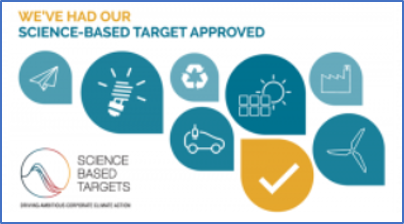 In October of 2019 (signature in July), Cellnex undertook to develop a Science-Based Emission Reduction Target over the next 24 months, which will be recognised by the Science-Based Targets Initiative (SBTi, https://sciencebasedtargets.org/). The Science-Based Targets Initiative, aligned with the Paris agreement (COP 21, 2015), is a joint initiative by CDP, the UN Global Compact, the World Resources Institute and WWF, that supports companies in setting emission reduction targets in line with the level of decarbonisation required to keep the global temperature increase below 2ºC compared to pre-industrial temperatures. The targets are calculated using methodologies based on scientific knowledge and making it the dominant practice. The quantitative objectives for 2025 and other time horizons
will be defined in the future, depending on resources available to achieve them.
In October of 2019 (signature in July), Cellnex undertook to develop a Science-Based Emission Reduction Target over the next 24 months, which will be recognised by the Science-Based Targets Initiative (SBTi, https://sciencebasedtargets.org/). The Science-Based Targets Initiative, aligned with the Paris agreement (COP 21, 2015), is a joint initiative by CDP, the UN Global Compact, the World Resources Institute and WWF, that supports companies in setting emission reduction targets in line with the level of decarbonisation required to keep the global temperature increase below 2ºC compared to pre-industrial temperatures. The targets are calculated using methodologies based on scientific knowledge and making it the dominant practice. The quantitative objectives for 2025 and other time horizons
will be defined in the future, depending on resources available to achieve them.
In the same month, Cellnex joined the Global Compact initiative “Business ambition for 1.5ºC”. This is a global initiative, signed by more than a hundred companies, 10% of which are Spanish. The initiative sets out two areas of action: "1.5°C science-based targets", aligning its GHG emissions in all relevant areas with emission scenarios at 1.5°C, and "Zero Emissions Commitment" setting a public target to achieve zero emissions by 2050. In this way, the Group steps up and commits the business to set science-based targets aligned with limiting the global temperature rise to 1.5°C above pre-industrial levels.

In December, the Spanish Global Compact Network, together with the UN Global Compact, the Chilean Network and the British Network, held an event in the context of COP25 in which, in addition to presenting the commitments in the manifesto, publicly recognised the Spanish entities adopting Business Ambition for 1.5 °C.


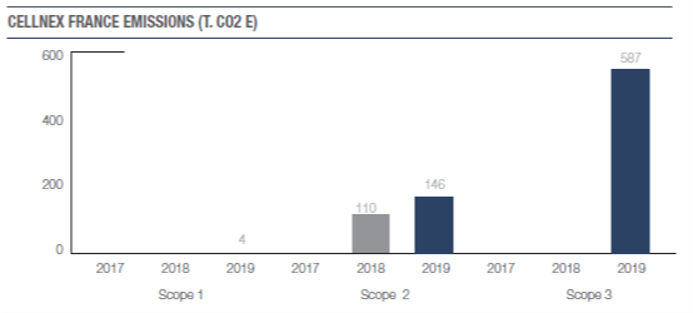
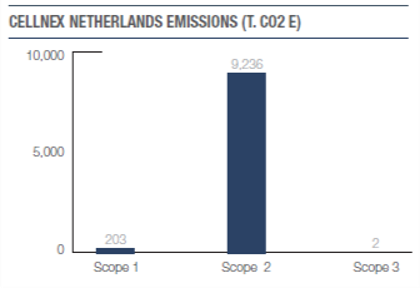

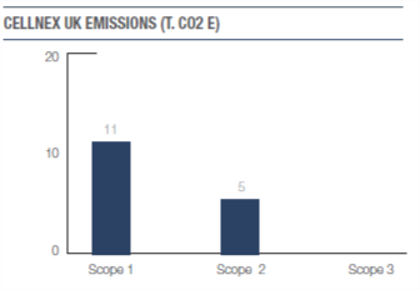
From a communication and awareness-raising standpoint, the company has released several communications of its actions:
- Publication of the company's carbon footprint report on the Cellnex corporate website.
- Registration in the Footprint Registry of the Spanish Climate Change Office under the Ministry of Agriculture, Food and Environment.
 Joining the Catalan Generalitat's Voluntary Agreements Programme for reducing greenhouse gas (GHG) emissions. This tool is promoted by the Catalan Office for Climate Change (OCCC) for companies seeking a voluntary commitment to reduce their GHG emissions beyond the statutory requirements.
Joining the Catalan Generalitat's Voluntary Agreements Programme for reducing greenhouse gas (GHG) emissions. This tool is promoted by the Catalan Office for Climate Change (OCCC) for companies seeking a voluntary commitment to reduce their GHG emissions beyond the statutory requirements.- Publication of the withdrawal of the carbon credits from the project selected in the Markit Environmental Registry or equivalent as evidence of the compensation made.
In addition, Cellnex has drawn up Sustainability Guidelines. This tool will help to ensure that the sustainability principles will be in place in companies close to acquisition. Furthermore, this tool will help measure our positioning on the market in relation to other companies in the sector.
Biodiversity
By assessing and monitoring the aspects and impacts of Cellnex Spain, the organisation has identified the Effect on Biodiversity – the environmental impact associated with the loss of biodiversity of living beings and natural species –as one of its significant aspects. Indeed, one of the strategic lines of the Strategic Plan for Sustainability is “Natural spaces and biodiversity”.
Cellnex manages its facilities so as to minimise any type of environmental impact of its activities that affects biodiversity. It takes into account not only of the work of the company itself but also of its providers, since their maintenance work and services can have the greatest environmental impact. Cellnex works with its suppliers to ensure they are environmentally responsible and use best practices, for instance by properly managing waste and protecting biodiversity.
To ensure a proper management of these impacts, it is essential to diagnose the presence of Cellnex's activity in the most vulnerable areas. To that end, Cellnex Spain uses the Inventory of Natural Parks and Biodiversity Protection Areas. During 2019, the inventory was modified to take account of the updating of the regulations in this area. In 2019, Cellnex Spain assessed all the sites, including the sites purchased up to the first quarter of 2019, in order to assess whether the sites were in protected areas as well as any applicable regulations. In 2019, the surface area of the protected area affected by company activity was 193,585.4 m2.
In accordance with Strategic Plan for Sustainability, Cellnex will produce an environmental impacts map for 2020. We are also continuing to identify natural spaces and applicable regulation.
To monitor the company's impact on birdlife, Cellnex Spain uses signage to identify centres with nesting birds to establish whether a centre does in fact cause such an effect and to remind staff of the preventive measures to be taken. Likewise, in Cellnex Netherlands,nesting boxes were installed on 16 of the 24 Alticom towers for protected peregrine falcons .Moreover, during the breeding season, no work is allowed on platforms with nesting boxes.
Furthermore, as a key preventive environmental protection measure, every year Cellnex Spain notifies its employees of the start of the forest fire prevention campaign, when use of machinery that may cause fire is restricted on company facilities.
DaMA programme
Cellnex uses the DaMA (environmental data server) tool to display geographical data and identify declared natural protection sites in the country, this information is also found in the aQua Sites database. The server also provides access to environmental data relating to Cellnex Spain's sites.
Cellnex is also working on a new tool to manage the sites of all countries, which will allow each country to manage its sites. At the moment, the study has been completed to find out how many sites in each country are located in protected areas.
Electromagnetic emissions
Cellnex Telecom complies with the rules governing electromagnetic emissions for the general public and its workers. Pursuant to Royal Decree 299/2016, it conducts periodic measurements at technical centres with a permanent staff presence. As regards the general public, it ensures compliance with Royal Decree 1066/2001 at all sites in Spain. The regulatory framework in Italy is stricter and Cellnex Italy works to ensure compliance.
Cellnex works with expert groups in researching the impact of electromagnetic fields and takes part in activities related to assessing, managing and communicating the possible health risks of exposure. Specifically, Cellnex works with a subdivision in a department of DigitalES, the Spanish Association for Digitisation, formed mainly by telecommunications operators and Cellnex, which carries out activities related to radio emissions. This work involves examining issues of legal compliance and proposals for improvement, based on the recommendations of the International Electrotechnical Commission (IEC), in addition to studying 5G emissions.
Furthermore, in autumn 2018, the former Federal Councillor Doris Leuthard, head of the Department of the Environment, Transport, Energy and Communications (DETEC) in Switzerland, decided to set up a working group to discuss mobile communications and radiation. As new independent player and with its forward-looking infrastructure model, Cellnex Switzerland is part of the group and is helping to shape the future development of the mobile network. As a member, Cellnex, through its knowledge and experience, make a significant contribution to the established working group.
In addition, Cellnex is working with epidemiology research groups from ISGlobal (Barcelona Biomedical Research Park) by providing information on emission sources (television, radio, etc.).
Moreover, at Cellnex we are working with various groups, such as our employees and suppliers, to explain what 5G is and the consequences of this technology. These awareness-raising activities are aimed at improving knowledge on this subject among our stakeholders.

